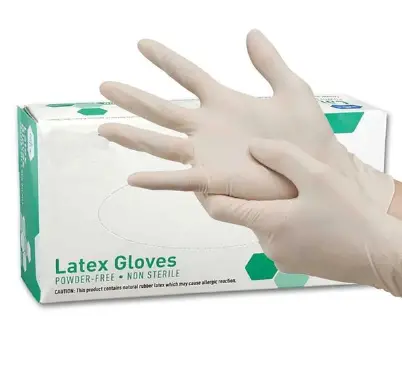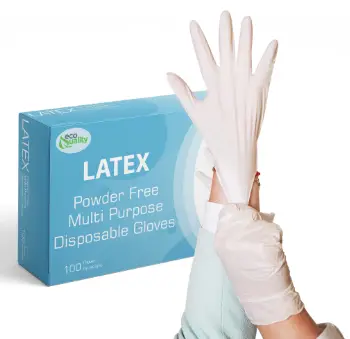
Gloves are essential in your kitchen operations. They offer protection when preparing food, cleaning, and handling organic solvents. Latex gloves are the commonest, but you may have had a bad experience. Skin reactions, undetectable punctures, and non-durability are some of the drawbacks that come with these gloves. Indeed, the material doesn’t offer much-needed protection against harsh chemicals and other organic solvents. So, what’s better than latex kitchen gloves?
Looking for better kitchen gloves than latex? Consider nitrile and poly gloves. These two are durable, puncture and chemical-proof. They are tight-fitting and give you a better clasp for your cutlery.
I will examine each one at a time;
Nitrile Gloves

Nitrile gloves are an exceptional substitute for latex gloves. The material has perfect oil absorbent qualities, which is a top consideration when buying gloves for food service.
Unlike latex gloves that contain rubber, nitrile gloves have a micro-foam material that does not puncture easily. At least nitrile is three times better and more resistant than latex. These gloves have a firmer grip, perfect for working in wet, oily, and dry situations.
Besides the micro-foam nitrile gloves, there is the sandy type. These are a premium version of micro-foam, offering a firmer grip. The gloves’ reinforcement includes dipping them in salt to form a sandy feel. The best thing about nitrile gloves is that they are non-allergic.
Properties/Pros
- Non-toxic
- Tight fitting
- Puncture resistant
- Oil absorbent
- Durable
- Outstanding grip
- Breathable
- Water repellant.
- Excellent touch sensitivity
- Allergy free
Cons
- Nitrile gloves are non-biodegradable.
- They are not adhesive-friendly.
Poly Gloves
If you want better kitchen gloves than latex, consider exploring poly gloves. These are transparent gloves that come with a loose fit for easy sliding. Also, the poly gloves are thin, so they are perfect for less intensive food preparation duties. They are great for serving and other non-intensive operations such as cleaning and salad preparation. Poly gloves will be better than latex kitchen gloves if you operate a bakery or fast food.
Properties/Pros
- Non-allergic
- Non-toxic
- Loose fit
- Low density
- Great grip
- Excellent tensile strength
- Lower particulate shed
- Excellent touch sensitivity
- Breathable
Cons
- They are not heatproof.
- Low touch sensitivity.
Are Latex Gloves Good For Kitchen?

While gloves are essential during food handling and prep, not all are good. Some, like latex gloves, cause contamination and skin irritation. Also, the powdered category compromises food hygiene. Although latex gloves have eco-friendly materials, they cause skin irritation to some users. Starchy powder is not safe for the food industry.
So, latex gloves are not safe for use in the kitchen, especially in food hygiene and preparation. Consider poly or nitrile gloves, which are inexpensive, non-allergic, puncture resistant, and extra tensile.
Pros And Cons Of Latex Gloves
Here are the pros and cons of latex gloves;
Pros
- They are inexpensive.
- Latex gloves offer a comfortable fit.
- They have excellent touch sensitivity.
- The gloves are biodegradable.
Cons
- Latex gloves cause skin irritation.
- They are not puncture-proof.
- It is not easy to detect holes and tears in latex gloves.
- Powdered latex gloves can cause food contamination.
- The gloves offer less protection against chemical irritants.
- They do not protect hands from abrasive materials.
Can You Use Medical Gloves For Food Preparation?

Using medical gloves in your kitchen may not stick out nicely in your mind. But the fact is, medical gloves pass the food safety standard, thus safe for food preparation. Hand safety coverings are the most typical type of gloves in most kitchens.
To ascertain the safety of medical gloves in food prep, the Food and Drug Administration, FDA, ensures that the protective wear passes through intensive clinical tests. The regulatory body ensures that they undergo several tests, including;
- Abrasion resistance
- Tensile test
- Elongation performance
- Puncture resistance
- Density test
- Chemical resistance test
- Aging test
- Sterility test
- Pinhole rate
- Friction coefficient, etc.
Final thoughts
Determining what’s better than latex kitchen gloves may be an uphill task, especially if you need to know the types of gloves in the market. We have given you two options for the latex gloves. You can have nitrile and poly gloves for different tasks in your kitchen.
The nitrile gloves offer more protection on your skin, plus they are non-allergic. The gloves are puncture-resistant, have a perfect grip, and have high touch sensitivity. They are ideal for chopping, cutting, and other tasks that require tight grips. You can slide in poly gloves when serving or doing jobs that do not involve firmer grips. Always protect your hands with the best quality gloves!


